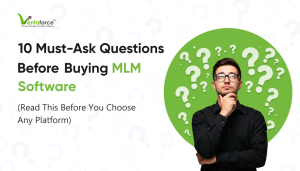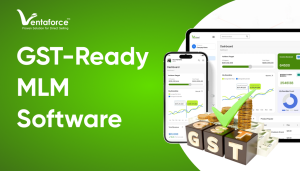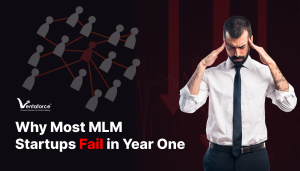What is MLM Software? The Ultimate Guide for Direct Sellers
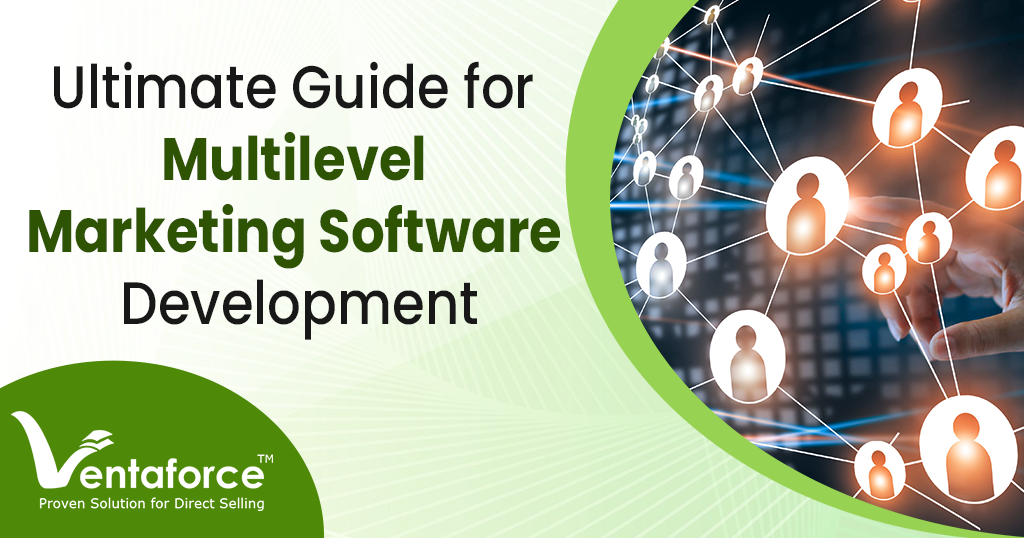
Highlights
- Learn what MLM software really is and why it matters
- Explore 15+ essential features with real-world examples
- Understand deep benefits for distributors and business owners
- Find tips for choosing the right MLM software development company
- FAQs answered using People Also Ask style questions
Introduction: Why MLM Software Is a Game-Changer
Running a direct selling business today is nothing like it was ten years ago. Back then, spreadsheets and manual commission calculations were enough. But now, businesses often have thousands of distributors across multiple countries, making manual tracking inefficient, error-prone, and stressful.
Take, for example, a company in India with 3,000 distributors. Each month, their finance team spent weeks calculating commissions manually, leading to delays, errors, and disputes. Distributors grew frustrated, and morale dropped. Once they adopted MLM software, commissions were calculated automatically, payouts were timely, and the team could focus on growth instead of paperwork.
The same story repeats globally — in the US, UK, Africa, and Asia. MLM software isn’t just a tool; it’s the backbone of a scalable, professional, and trustworthy direct selling business.
What Is MLM Software?
Multi-Level Marketing (MLM) software is the central nervous system of a direct selling business. It’s a digital platform that manages the everyday complexities of network marketing — from tracking distributors and calculating multi-level commissions to ensuring accurate payouts and maintaining transparency across the entire network.
Running an MLM company without dedicated software can feel like trying to pilot a jet with no dashboard. At first, it might seem manageable with spreadsheets or manual records. But as your network grows — from a few dozen members to thousands spread across cities or even countries — things spiral out of control. Errors increase, payouts get delayed, and distributors lose trust.
That’s exactly why MLM software exists. It takes care of all the repetitive, time-consuming, and error-prone tasks, so business owners can focus on growth, strategy, and supporting distributors.
Why Is It Important?
- Accuracy: Commissions are calculated instantly and without mistakes.
- Efficiency: No more weeks wasted preparing reports or handling disputes.
- Scalability: The system grows with you — whether you manage 50 distributors or 50,000.
- Transparency: Distributors see their earnings and genealogy structure clearly, reducing conflicts.
A Real-World Example
Imagine a network marketing company in India with 2,000 active distributors. Each month, hundreds of transactions occur daily. Without software, the finance team spends weeks calculating who earns what. Mistakes slip in, disputes rise, and the company’s credibility suffers.
With MLM software, however:
- Every sale is recorded in real-time.
- Commissions flow automatically up the genealogy tree.
- Payouts happen on schedule.
- Distributors can log in anytime to track their performance and income.
This shift doesn’t just save time — it builds trust, which is the lifeblood of any MLM business.
In Simple Words what is MLM Software development?
MLM software is more than just a tool. It’s the foundation of a professional, transparent, and future-ready MLM business. It helps companies expand confidently, motivates distributors with timely rewards, and keeps operations running smoothly even as the network grows worldwide.
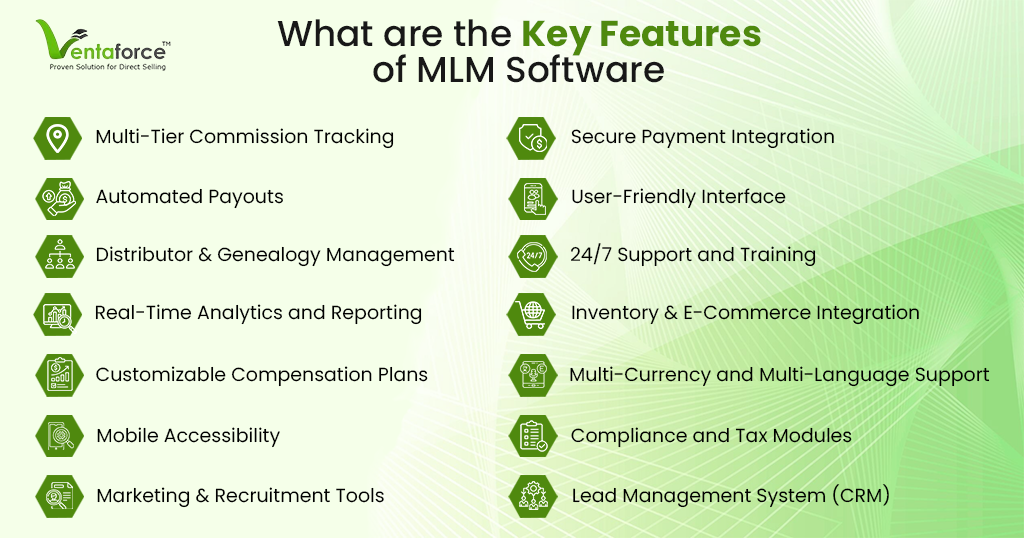
Up to Date Key Features of MLM Software
1. Multi-Tier Commission Tracking
This feature automatically calculates and allocates commissions across every level of your network — from the direct seller to multiple uplines. It understands the math of binary, matrix, unilevel or hybrid plans and applies rules (percentages, caps, carry-forwards) consistently so no one is missed. For admins it becomes a single source of truth; for distributors it’s transparent — they can see exactly how each sale translated into their earnings. In practice this prevents long argument-filled email threads and massively reduces finance workload.
Example: A distributor in London sells a product. The system instantly calculates and distributes commissions to uplines in the US and India, eliminating errors and delays.
2. Automated Payouts
Automated payouts take the manually-intensive, error-prone job of paying commissions off your plate and moves it into a scheduled, auditable process. The platform can batch payouts, convert currencies, and push funds through trusted gateways so distributors get paid on time. This builds trust — people keep working when payments are reliable — and removes the recurring headaches of manual payroll reconciliation. You can also configure thresholds and payment windows to control cashflow.
Example: A distributor in Kenya received their commission instantly, eliminating weeks of waiting and building trust in the system.
3. Distributor & Genealogy Management
Genealogy tools visualize the entire upline-downline structure in an interactive tree: who sponsored whom, where placements sit, and which legs are growing. Admins can drill down into any distributor’s activity, view recruits, sales history and contact details in one place. For leaders, genealogy makes mentorship and corrective action simple — they spot gaps and inactive legs quickly. It’s also invaluable during audits or disputes because historical placement and sponsorship data is preserved.
Example: A US MLM leader noticed low-performing distributors and assigned mentorship programs through the software, boosting overall network productivity.
4. Real-Time Analytics and Reporting
Instead of waiting for monthly spreadsheets, real-time dashboards show live sales, active recruits, commission burn, and product-wise performance. You can filter by region, rank, or time period and export reports for finance or tax filing. This allows quick tactical moves — e.g., launching a promo in a low-performing city — and strategic decisions like changing compensation for underperforming SKUs. The data also helps you forecast payouts and manage cashflow proactively.
Example: A German MLM company used analytics to spot declining sales in Europe and launched a targeted campaign, increasing sales by 18% in just three weeks.
5. Customizable Compensation Plans
Every company has its own business model — your compensation should fit it, not the other way around. Customizable compensation plans let you define rules for commissions, bonuses, rank advancements, capping, and carry-forward logic without rewriting code. That flexibility is crucial when you test new incentives or expand into new markets with different expectations. It also lets you implement promotional temporary plans (like launch bonuses) and revert easily when the campaign ends.
Example: An Indian startup initially used a unilevel plan but scaled to a hybrid model. The software handled the transition seamlessly.
6. Mobile Accessibility
Most distributors build their business on phones, not desktops. A mobile app or responsive portal gives them instant access to earnings, product catalogs, leaderboards, and prospecting tools — anywhere, anytime. This boosts recruitment and activity because actions (enrollments, orders, follow-ups) happen in the moment. For you, mobile accessibility increases adoption rates and reduces support calls caused by “I can’t see my balance” problems.
Example: A distributor in Singapore signed up a new recruit while commuting, directly through the mobile portal.
7. Marketing & Recruitment Tools
Built-in marketing features provide distributors with ready-to-use email templates, social share links, referral tracking, and landing pages — so they don’t have to be marketing experts to recruit or sell. Campaigns can be localized, tracked, and tied back to distributor performance so you know which creative actually convert. These tools shorten the time from lead to sale and make it easier to scale recruiting efforts across regions.
Example: A US distributor launched a social media campaign via the platform, resulting in 50 new recruits in one month.
8. Secure Payment Integration
Integrating trusted, PCI-compliant payment gateways (and local payment methods) ensures customer and distributor transactions are safe and frictionless. The platform encrypts sensitive data, supports local settlement rules, and provides transaction logs for reconciliation. Security reduces chargebacks and fraud risks and is a strong trust signal for recruits who might otherwise be hesitant to join a network.
9. User-Friendly Interface
A clean, simple interface reduces friction for new distributors and lowers training costs. When menus, dashboards, and payout statements are intuitive, people actually engage with the platform — they check updates, submit orders, and follow up on leads. Faster adoption means your organization sees the benefits sooner, and support tickets drop because users can self-serve basic tasks.
10. 24/7 Support and Training
Round-the-clock support — plus an organized knowledge base and short video tutorials — keeps distributors productive and reduces churn. New recruits can complete onboarding modules at their own pace and find answers without calling admin. For admins, ticketing and escalation workflows mean technical issues are tracked and resolved quickly, so business continuity is protected.
11. Inventory & E-Commerce Integration
When product sales drive your MLM, syncing inventory prevents overselling and automates reorder triggers. Integration with shopping carts and warehouses updates stock levels as orders flow in and shows shipping status within distributor dashboards. This reduces customer service complaints, improves delivery times, and protects your reputation during peak seasons or promotions.
Example: A UK MLM company avoided overselling during a holiday promotion because the software flagged low inventory automatically.
12. Multi-Currency and Multi-Language Support
A global business needs local experiences. Multi-currency support handles conversions and settlement logic; multi-language interfaces let distributors interact in their preferred language. Localized tax/VAT handling and region-specific payment options remove administrative barriers to expansion and make onboarding smoother for new markets.
Example: Distributors in France view dashboards in euros and French, while Indian distributors see rupees and Hindi.
13. Compliance and Tax Modules
Built-in KYC, AML, GDPR and tax reporting features keep you on the right side of regulators. The Compliance Ready MLM Software can collect required identity documents, store consent records, and produce tax statements for distributors and authorities. Compliance reduces legal risk and makes it easier to enter new jurisdictions with different regulatory demands.
Example: A European MLM company ensured GDPR compliance for every new distributor without manual intervention.
14. Lead Management System (CRM)
A CRM captures leads (website forms, landing pages, events), automatically assigns them to the right distributor by geography or rank, and tracks nurture activities until conversion. This prevents “lost leads” and provides visibility into conversion rates by campaign, by distributor, and by source. For leaders, it’s a productivity tool — they can coach based on actual lead response data.
Example: New website inquiries are assigned to the nearest distributor, increasing conversion rates by 20%.
15. Training & Knowledge Base
A searchable knowledge base, short how-to videos, and certification paths help distributors learn faster and maintain compliance with brand messaging. Training modules tied to rewards encourage completion and create a more professional sales force. This makes growth sustainable — instead of one-off spikes from charismatic recruiters, you build a repeatable process for scaling skill across the network.
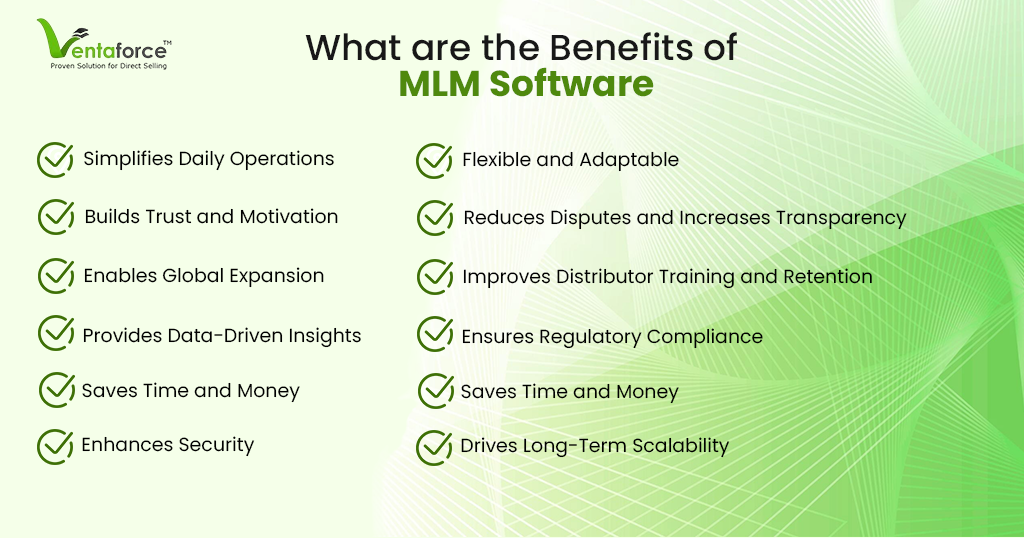
Benefits of MLM Software
1 . Simplifies Daily Operations
Without software, admins spend hours juggling spreadsheets, calculating commissions, and handling disputes. MLM software automates all these repetitive tasks, freeing your team to focus on sales and recruitment. Imagine reducing a week’s worth of manual commission work into a process that takes minutes — that’s the kind of simplicity this software brings.
2. Builds Trust and Motivation
Distributors join an MLM business because they believe their hard work will be rewarded. Delayed or incorrect payouts damage that trust instantly. With MLM software, payouts are on time and transparent, boosting morale. A motivated distributor is not only more loyal but also more likely to recruit others — trust fuels growth.
3. Enables Global Expansion
Growing across borders is difficult if every country uses a different system. MLM software supports multiple currencies, languages, and tax rules, so you can run one unified network worldwide. For example, a sale in India can be logged in rupees while an upline in the US receives their commission in dollars — automatically. This makes international growth seamless.
4. Provides Data-Driven Insights
Guesswork often leads to wasted marketing spend or ineffective strategies. MLM software provides real-time analytics — who’s selling the most, which products are lagging, and where new recruits are coming from. Leaders can use this information to make smarter decisions, like running region-specific promotions or adjusting compensation plans to boost engagement.
5. Saves Time and Money
Every hour spent on manual calculations or correcting mistakes is time wasted. By automating core processes, MLM software reduces the need for large admin teams and minimizes human errors. Over time, this efficiency translates into significant cost savings, which can be reinvested into product development, marketing, or distributor training.
6. Enhances Security
Handling thousands of transactions means handling sensitive personal and financial data. MLM software uses encryption, secure gateways, and audit trails to keep this information safe. This doesn’t just protect your business from fraud — it builds confidence among distributors who know their earnings and details are secure.
7. Supports Growth and Recruitment
Recruitment is the lifeblood of direct selling. Built-in marketing tools — like referral links, landing pages, and email campaigns — help distributors grow their networks faster. Combined with performance dashboards, leaders can identify top recruiters and incentivize them further. This makes growth structured and measurable instead of random and untrackable.
8. Flexible and Adaptable
As your business evolves, so do your compensation strategies. Whether you want to shift from a binary to a hybrid model or introduce temporary promotional bonuses, MLM software adapts without disrupting operations. This flexibility ensures your network stays competitive and aligned with market trends.
9. Reduces Disputes and Increases Transparency
Commission disputes are one of the biggest challenges in MLM businesses. When everything is automated, transparent, and visible in dashboards, disputes drop dramatically. Distributors can log in and see exactly how their earnings were calculated, which prevents arguments and creates a culture of fairness.
10. Improves Distributor Training and Retention
High churn is common in direct selling when new recruits feel unsupported. With integrated training modules and knowledge bases, MLM software equips distributors with the tools they need to succeed. When people feel supported and earn consistently, they stay longer — saving you from constantly restarting recruitment efforts.
11. Ensures Regulatory Compliance
Global MLMs often struggle with compliance — whether it’s tax filing, GDPR in Europe, or KYC in India. MLM software automates these processes, reducing legal risks. By staying compliant, you safeguard your brand’s reputation and make it easier to operate in multiple regions without fear of penalties.
12. Drives Long-Term Scalability
The biggest benefit of all is scalability. A system that works for 100 distributors often breaks at 10,000. MLM software grows with you — handling more distributors, more transactions, and more complexity without losing accuracy or speed. This scalability is what separates a small network from a global MLM brand.
How to Choose the Right MLM Software Development Company
When selecting a MLM Software Development partner:
- Look for experience in MLM solutions
- Ensure customization options for your business model
- Check scalability for future growth
- Verify ongoing support and updates
- Review reputation through case studies and testimonials
Remember: the right partner becomes a long-term collaborator, not just a vendor.
Conclusion
Now a day’s, MLM software is not optional — it’s the foundation for scalable, transparent, and efficient direct selling businesses.
From simplifying operations to motivating distributors and enabling global expansion, the right software transforms your MLM business. Partnering with a trusted MLM software development company ensures your platform is customized, scalable, and future-ready.
Start today — empower your distributors, streamline operations, and grow your business globally.
Frequently Asked Questions
MLM software is designed to simplify the daily operations of a direct selling business. It tracks every distributor in your network, records sales, and calculates commissions across multiple levels instantly. It also helps manage genealogy trees (upline and downline), generate real-time performance reports, and even supports marketing campaigns with tools like referral links and email automation. In short, it’s the backbone that keeps your MLM business transparent, efficient, and scalable.
The cost of MLM software depends on your business size, required features, and level of customization. Small businesses may get started with basic packages 249$, while enterprise-level solutions with advanced features like multi-currency support, compliance modules, and e-commerce integration can cost significantly more. Instead of focusing only on price, consider the long-term ROI — a well-built system reduces errors, saves time, and builds trust among distributors, which directly translates into growth.
Yes, modern MLM software is built for global expansion. It supports multiple currencies (like INR, USD, GBP, and more), offers dashboards in different languages, and includes compliance modules for international regulations such as GDPR in Europe or KYC in India. For example, a distributor in the US can view their earnings in dollars, while their upline in India sees commissions in rupees — all handled automatically. This makes cross-border network management seamless.
Absolutely. Every MLM company has unique needs, from compensation plans to product types. Good MLM software allows you to customize binary, matrix, hybrid, or unilevel plans, adapt dashboards to your brand, and integrate with your existing e-commerce or payment systems. This flexibility ensures the software aligns with your business model instead of forcing you to adjust your strategies around rigid technology.
Development timelines vary depending on complexity. A simple system with basic distributor tracking and commission management can be ready in 2–3 months. However, if you require advanced features like multi-currency support, mobile apps, e-commerce integration, and compliance modules, it may take 4–6 months or more. The key is to work with an experienced MLM software development company that follows an agile process, ensuring you start with the essentials and scale as your network grows.
Security is critical in MLM businesses since you’re handling thousands of transactions and sensitive distributor data. Reliable MLM software uses SSL encryption, secure payment gateways, two-factor authentication, and audit logs to protect information. Some also include fraud detection systems to prevent misuse. This level of security not only safeguards your business but also builds trust with your distributors.
Any business that relies on multi-level marketing strategies can benefit from MLM software. Whether you’re a startup with 50 distributors or an established brand with 50,000 members, the software helps streamline operations. Startups use it to scale quickly without drowning in manual work, while large enterprises rely on it to manage global networks and complex compensation structures.

